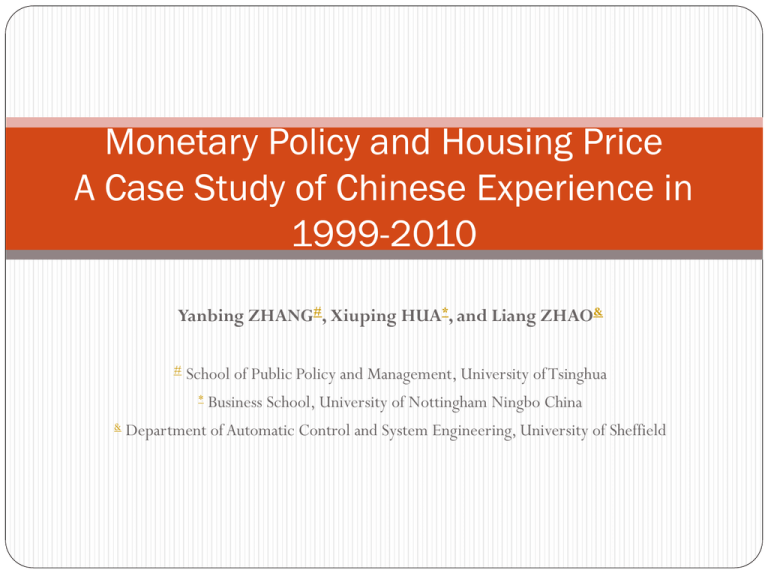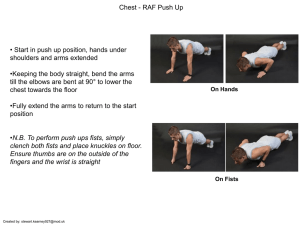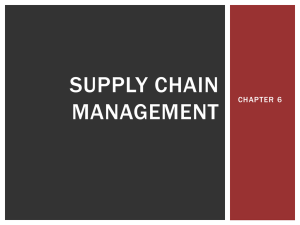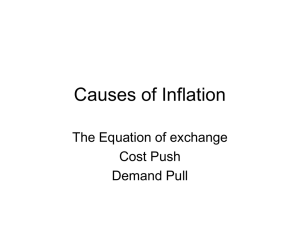Monetary Policy and Housing Price A Case Study
advertisement

Monetary Policy and Housing Price A Case Study of Chinese Experience in 1999-2010 Yanbing ZHANG#, Xiuping HUA*, and Liang ZHAO& # School of Public Policy and Management, University of Tsinghua * & Business School, University of Nottingham Ningbo China Department of Automatic Control and System Engineering, University of Sheffield Outline Research Background Existing Explanations of Chinese House Market Boom Data and Methodology of this research Empirical Results Conclusions and Policy Implications 1.Background Decline of housing prices in the US beginning from 2007 eventually led to global financial crisis; Some people believe the Chinese bubble is even bigger than the US one before the crisis Chinese experiences during the past : (1) From the second half of 1998, housing privatization had become the mainstream of housing policy and the market gradually became the main way for providing residential housing in urban area. (2) Housing prices in major cities such as Beijing and Shanghai more than tripled between 1999 and 2010; (3) Total value of China’s residential housing market reached 91.5 trillion yuan at the end of 2009, nearly three times the size of GDP in the same year. Figure 1 Official statistics of China’s house market an average rate of 25.82% an average rate of 5.09% 1a. Year-on-year Quarterly Growth Rates of Real Estate Investment 1b. Year-on-year Quarterly Growth Rates of House Price Index 0.45 14% 0.4 12% 0.35 10% 0.3 8% 0.25 0.2 6% 0.15 4% 2010/06 2009/09 2008/12 2008/03 2007/06 2006/09 2005/12 2005/03 2004/06 2003/09 2002/12 2002/03 2001/06 2000/09 -2% 1999/12 2010/06 2009/09 2008/12 2008/03 2007/06 2006/09 2005/12 2005/03 2004/06 2003/09 2002/12 2002/03 2001/06 0% 2000/09 0 1999/12 2% 1999/03 0.05 1999/03 0.1 Recovery of house market in 2009 Boosted by massive economic stimulus package by the government to deal with the global crisis, both real GDP and housing prices in China rose again in the second quarter of 2009, in a quick recovery from growth rate falls of late 2008 and early 2009. GDP growth rate picked up to 7.4% in the second quarter and accelerated to 9.10% in the fourth quarter in 2009. House prices recovered quickly too, and their year-on-year growth rates increased to 5.8% in the fourth quarter of 2009, 11.7% and 11.4% in the first and second quarters of 2010, respectively Policy Action Surging housing prices had led to increasingly open discontent from many urban families in major cities; Meanwhile, concerns about potential risks of bubble bursting in the housing market prompted the policymakers in China to take various policy actions containing housing bubbles. One of the most dramatic tightening package was introduced in April 2010, which focused mainly on administrative measures. ‘State Eight Policies’ on 26 Jan. 2011 extended and strengthened the control policies introduced earlier, especially for demand management. Such controls, however, did not appear to be effective. Whenever there was a sign of government relaxing the controls, housing prices began to rebound rapidly. The Policies, for example (1) raising down-payment ratio from 20% to 30% for first home buyers, (2) reducing mortgage rate discount from 30% to 15% of benchmark interest rate, (3) prohibiting the same family from purchasing a second or more properties, suspending mortgage loans to non-residents of a city unless they can prove that they have paid taxes in that city for at least one year. (4) a proposal considering the extension of the property tax Aims of Research (1) to explore the determinants of China’s housing price; (2) to apply a non-linear modeling approach, NARMAX, which automatically selects forms and lag terms of individual explanatory variables; (3) to draw some policy implications for the management of housing prices or housing bubbles in China. Existing explanations (E1) Income and demand push (E2) Monetary policy push (E3) Inflation or user cost push (E4) Land price push (E5) Exports or international trade momentum (E6) Exchange rate fluctuation push (E7) Hot money push (E8) Foreign reserve accumulation push (E9) Stock market wealth push (E10) Rural-urban migration and urbanization (E11) Other momentums: inefficient house supply push, market structure push (E1) Income and demand push Increasing household income or personal disposable income, which resulted from rapid 30 years’ economic growth as well as high household saving rate and scale in China. Income variables for studying income effects in E1, including personal disposable income (PY), real GDP output (Y), and value-added industrial output (VAI). The real GDP is only published quarterly while we need monthly observations. To overcome this problem, we use the method of Cubic Spline Interpolation to split the data. (E2) Monetary policy push It is widely accepted that monetary variables affect not only goods prices but also asset prices (Rigobon and Sack, 2004). It is argued the sharp increase in property prices in 2009 as a consequence of the extremely loose monetary policy adopted by the Chinese government to counter the global financial crisis, such as easily-attainable bank loans and discounts in interest rates. Two measures of monetary policy namely an average of medium and long-term Mortgage rates (MR) and a broad monetary aggregate (M2), are adopted for testing E2. (E3) Inflation or user cost push the limited financial sector offers few other investment options in China. Some argue that the current growing demand in the housing market is due to certain companies and investors’ fear of inflation. Popular measures for inflation in China include two goods price indices (consumer price index (CPI) and producer price index (PPI)) and a national rent index (R) are used to test inflation push in E3. (E4) Land price push Local governments’ dependence on land financing, namely local governments have strong incentives and abilities to generate significant revenue from the sale of ‘land use rights’. The soaring land price pushes up the house price. A national land price index (L) is used to investigate the effects of land price in E4. (E5) Exports or international trade momentum China has taken exports or international trade for its economic growth in the past decades. Fast increment of international trade volume has contributed much to the booming of Chinese economy in the recent years and hence may provide a momentum for house price changes. To test E5, growth rates of both exports (EX) and imports (IM) are directly adopted rather than calculating trade openness by total value of exports plus imports divided by GDP. (E6) Exchange rate fluctuation push Many have argued that China’s exchange rate policy played a critical role in its international trade and Foreign Direct Investment (FDI) booms and improved China’s competitiveness in attracting FDI flows to China as well as creating favourable conditions for maximizing exports, such as Xing (2006). Such arguments suggest exchange rate fluctuations may influence house price changes. To assess E6, real effective exchange rate index (REER) is collected. (E7) Hot money push The speculative capital flow or ‘hot money’ due to RMB appreciation expectations is one of main factors helped accelerate the bubble. To test E7, following Guo and Huang (2010), we define a new variable hot money (HM) which is calculated by (change in foreign exchange reserves) minus (trade and service balance) minus (foreign direct investment). The 12 Month RMB/dollar Non-deliverable Forward contracts (NDF) is also collected for measuring the effects of RMB appreciation expectations. (E8) Foreign reserve accumulation push China’s relative stabilization policy of RMB exchange rate against the dollar as well as the corresponding huge amount of foreign exchange reserve and hence a large credit expansion as well as a relatively low (negative) interest rate, which helps to produce an increase in the house demand and hence impact house price changes to a large extent. To test E8, the foreign exchange reserves (FR) is collected, (E9) Stock market wealth push According to the statistics published by World Federation of Exchanges (WFE), in January 2008 and July 2009, China had overtaken Japan to become the world’s second-biggest stock market by capitalization twice. By end of 2009, the Shanghai and Shenzhen stock exchanges list around 1,700 companies and have a market capitalization of US$3.57 trillion. It comes naturally to assume that China’s stock market wealth may play a significant role in push up house price. To test E9, a stock price index (the Shanghai Stock Exchange Composite Index, SP) is used. (E10) Rural-urban migration and urbanization Chen et al (2011) explore the possible effects of rural-urban migration and urbanization on China’s urban housing prices and find that varieties of provincial urbanization process and migration situation have significant effect on urban housing prices in China. It is hard to find monthly or quarterly aggregate data. No test on this explanation. (E11) Other momentums inefficient house supply push In an attempt to achieve a high GDP growth rate, the Chinese government encouraged commercial housing construction and investments (Liu et al., 2002) and hence had no motivation to supply enough economic affordable housing. The inefficiency in house supply results in higher house price. market structure push Market structure push points to the participation of large State-owned enterprises (SOEs) in the real estate market. Large SOEs can mobilize their own cash flow and loans from state banks to participate in the house market. They can afford to hold the market because they can privatize the benefits and socialize the risk. In such a case, house price keep souring up. It is hard to find monthly or quarterly aggregate data. No test on these explanations. 4. Data and Methodology 4.1 Data monthly time series from January 1999 to June 2010; Dependent variable: a national house price index (H), 16 Independent variables: a national land price index (L), a national rent index (R), average of medium and long-term Mortgage rates (MR), personal disposable income (PY), nominal GDP output (Y), value-added industrial output (VAI), two product price indices (CPI and PPI), a broad monetary aggregate (M2), the real effective exchange rate index (REER), the 12 Month RMB/dollar Non-deliverable Forward contracts (NDF), a stock price index (the Shanghai Stock Exchange Composite Index, SP), exports (EX), imports (IM) and Foreign exchange reserves (FR). Hot money (HM) which is calculated by (change in foreign exchange reserves) minus (trade and service balance) minus (foreign direct investment). In together there are 17 monthly series are exploited, and each series contain 138 observations. The data are collected from the Wind Database, China Economic Information Network Statistic Database (CEI), and Bloomberg database. 4.2 NARMAX As a generalization of the ARMAX model, the NARMAX method has been proved to be successful in modeling numerous real world nonlinear systems. It was proposed by Leontaritis and Billings (1985). Based on the NARMAX model specification, the Orthogonal Forward Regression (OFR) algorithm and Error Reduction Ration (ERR) definition were introduced by Billings et al.(1988, 1989), Korenberg et al. (1988), Chen et al.(1989), Billings and Zhu (1994) to provide an efficient way to determine the most significant terms among the candidate model term set. It has successfully modelled many real world nonlinear systems in engineering including chaotic electronic circuits, water management systems, turbocharged diesel engines, etc (Billings and Coca, 2001). It is also extremely useful in linear case when the number of candidate variables or terms is high. The structure of the model can be formatted by selecting the terms with ERR above a chosen cutoff value. The final selected model will be consisted only of most significant terms. 5. Empirical Results 5.1 Modelling with only NARMAX technique 5.1.1 Linear house pricing model Selected terms for linear house price model 5.1.2 Non-Linear house pricing model The polynomial NARMAX representation for the house price dynamics has included all possible combinations of the variables. In this research, we set n=12, and the second degree nonlinear terms of the nonlinear house price model produces over 20000 potential model terms. In practice, many of the terms will not be significant or redundant and can be removed. Selected terms for non-linear house price model 6. Conclusions and policy implications Main Findings Firstly, the empirical linear modelling results indicate that the changes of mortgage rates have the largest and negative effect on changes in house prices, while changes in all the other four factors have positive but less significant effects. Secondly, empirical nonlinear modeling reveal that product of mortgage rates and value-added industrial outputs, product of producer prices and GDP growth, product of real effective exchange rates and stock index, product of export growth and hot money, and product of house price index and producer price index, are dominating in the determination of house prices. Policy implications IF the date and methodology of this study can be trusted: The Chinese government should probably adjust the monetary policies, bank lending in general and mortgage rate in particular, in order to contain the housing bubble. Thank you! Welcome comments and questions.







